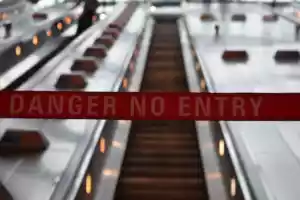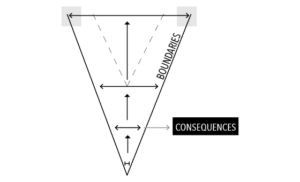Back in high school, I wrote a research paper about Elizabethan theater and how the constraints and restrictions surrounding theater at the time actually helped contribute to Shakespeare’s success by creating an environment in which he could thrive. It seems counterintuitive: how is banning certain subject matter a good thing? Doesn’t limiting freedom hinder creativity? Well, in this case, and in many others, having a clear boundary allows you to live freely inside the given constraints, not worried about whether or not you’re crossing the line.

This is really about clarity. You see, when we know what the rule is, we know when we’re breaking it. The problem is that there is rarely an instance where there are actually no rules. Instead, there are often unspoken rules that you have to tiptoe around and hope you don’t accidentally break.
The Freedom V
 The Freedom V is a mental model used to help us visualize how to live inside constraints. The walls of the V represent external boundaries. These can include the laws of nature, the laws of government, societal rules, etc. Outside of the V are consequences for crossing the boundary. And inside the V is where you can live freely and make your own choices within those constraints.
The Freedom V is a mental model used to help us visualize how to live inside constraints. The walls of the V represent external boundaries. These can include the laws of nature, the laws of government, societal rules, etc. Outside of the V are consequences for crossing the boundary. And inside the V is where you can live freely and make your own choices within those constraints.
You will be in different places inside the V at different times in your life. When you are young, you are at the bottom of the V where the boundaries are close and you don’t have as much freedom. This is because you haven’t yet learned how to set your own internal boundaries and need more external assistance to teach you how to live wisely.
But as you mature and are able to practice self governance, you will be moved up the Freedom V and have more choices available to you. The idea is that as you move up the Freedom V, and your boundaries widen, you take responsibility for setting personal boundaries that narrow the V. Self governance is the ability to discern boundaries for yourself and create structures that uphold them.
Planning to be home by 10:00 PM when you have to be up early the next morning for work is an example of a personal boundary. You no longer have a parent setting a curfew, but you can still set one for yourself.
Having more freedom and choices in front of us does not mean that we have to, or should, take this freedom as far as we can. Just because I can come home at 2 AM on a weeknight doesn’t mean that I should. A sign that you are ready to move up the Freedom V is that you set constraints on yourself that are tighter than the external boundary.
Giving yourself tighter restrictions is not about being strict, adhering to a new list of implied rules, or giving away your newly earned freedom. Instead, it is about clarity and purpose. If you have your values in place, then you can make decisions that help you get There. It’s about cutting out distractions to help you focus on what matters.
If you have clear delineations between what will help you get where you want to be and what will not, then you can spend your time freely pursuing your There unencumbered by worry.
Gracie McBride is the Content and Systems Management Coordinator for The Crossroad.




